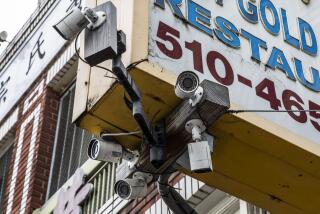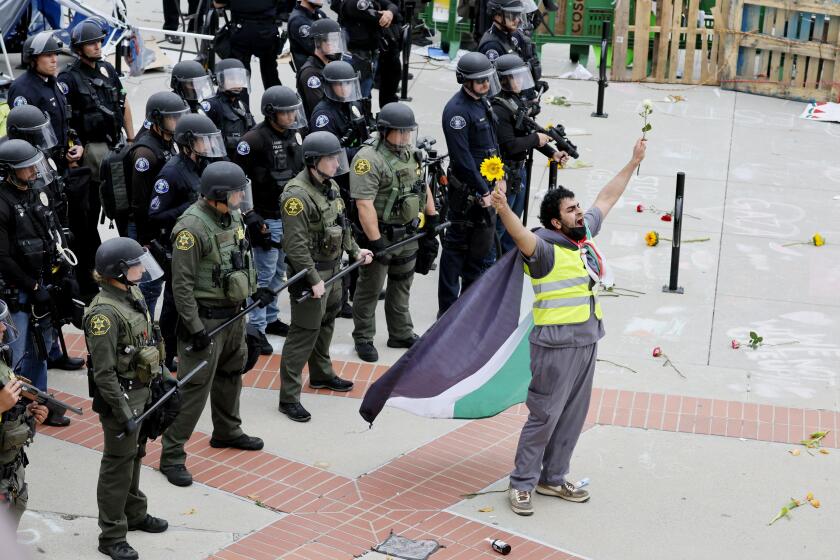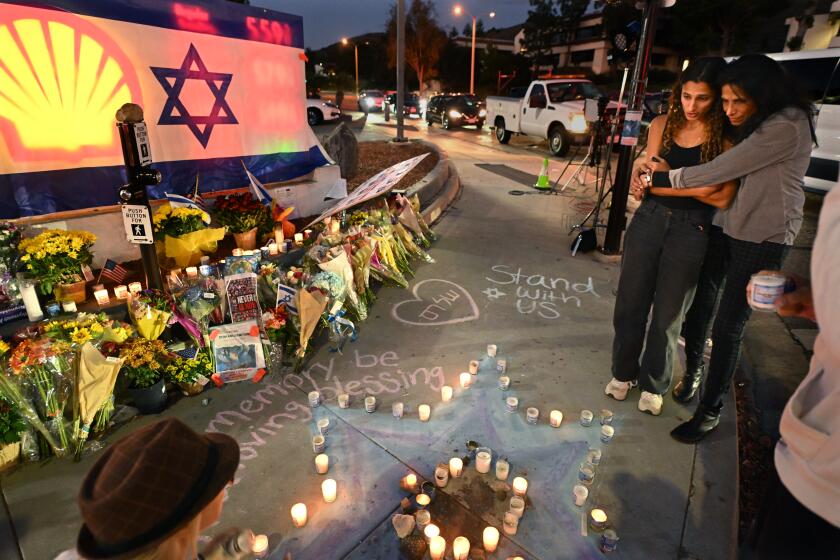Latest in Police Gadgets
Recently, law enforcement officials from around Orange County gathered at the Santa Ana police station to shoot water from a strange-looking pistol at a series of targets.
They were testing a new, “less-than-lethal” weapon designed to subdue suspects without seriously injuring them. If ever used on the street, it won’t be spurting water but disabling chemicals like pepper spray.
It’s one of dozens of gizmos that cross the desk of Lt. Collie Provence, who is in charge of training for the Santa Ana Police Department. Provence and other officers across Southern California test hundreds of devices each year on a quest to find better law enforcement tools that will make police work more effective and safer.
But only a few of the devices make the cut.
“A lot of times, the equipment may be different, but it doesn’t make it better,” said Provence, who hasn’t decided whether to purchase the pepper spray shooter. “In some cases, it may not be as good as what we currently have.
“I’m amazed at some of the technology that comes across,” he said. “A company comes to me, and they say, ‘I’ve developed a better mousetrap here,’ and in some cases, I think they have.”
Take the Printrak.
The fingerprinting system was fast, which is what Jim Conley wanted when he examined the product a few years ago. The forensic department supervisor for the Anaheim Police Department knew it took days for the current system to match prints and identities.
Printrak’s computer matched prints and identities of locally known criminals in five minutes. It could match prints to criminals elsewhere in California in two hours.
Anaheim police purchased the equipment in 1997, and since then it has helped nab criminals quickly. Just recently, Conley said, the fingerprinting system stopped a series of car thefts by quickly identifying the culprit, a man with a prior record.
“If you look at Anaheim, you’ll note that we have a lower crime rate, and the reason for that is technology,” Conley said. “I honestly believe fingerprint reporting contributes to it. The faster you get these types of criminals in custody, the less victims you have.”
Remote-Control Rifles, Stomach-Ache Guns
Through the years, Sid Heal, a lieutenant with the Los Angeles County Sheriff’s Department, has seen it all: remote-control rifles, pellets that unleash an odor so vile they can disperse angry mobs in seconds, even a gun that uses sound waves to induce stomach cramps and diarrhea.
Heal can’t recall where he first heard about the ShotSpotter, but like almost everything else that comes to him, it smacked of science fiction.
The system, which uses microphones scattered through the neighborhood and connected to a central computer, was billed as a way for police to detect gunfire, trace the shots to within 40 feet of its location and dispatch officers to the scene.
The ShotSpotter was already in place in Redwood City, where after two years, celebratory New Year’s Eve gunfire--once an epidemic--had all but vanished.
Heal tracked down the developer, a tiny Silicon Valley technology firm. He’d heard of similar gunshot detection systems but “nothing like this,” he said.
“It’s a passive system,” he noted. “It requires no human monitoring. That was very attractive.”
Heal eventually coaxed Trilon Technology to bring the ShotSpotter to Los Angeles, where the volume of gunfire on New Year’s morning--and any other day of the year--dwarfs that in Redwood City.
The system is being tried in a square-mile area of Willowbrook, one of 17 pilot projects the Sheriff’s Department has launched in four years as part of its technology exploration program.
Once the kinks were straightened out with the ShotSpotter, it has proved to be a useful tool, Heal said. Since March 13 it has prompted about 35 police responses and one arrest.
‘This Is a Recording: Did You Hear a Shot?’
When the ShotSpotter’s six-month trial expires June 30, the department must decide whether to purchase the system for $185,000, suspend the project or abandon it altogether. But even if the ShotSpotter doesn’t pan out, the cost to taxpayers will have been virtually nothing.
Also being tested is the Communicator, a companion technology that dials telephones in the vicinity of gunfire and plays a recorded message, entreating residents to call police with any information.
Heal, a 32-year veteran of the Marine Corps, was the lead military advisor during the evacuation of United Nations peacekeepers from Mogadishu, Somalia, in 1995. When he returned, the Sheriff’s Department put him in charge of acquisition for its technology committee. He has become one of the nation’s foremost experts on what law enforcement calls “less-than-lethal” weaponry.
When the Los Angeles Sheriff’s Department established its technology exploration committee in 1996, military contracts were drying up in the post-Cold War era. As a result, developers were scrambling for new markets, paving the way for a new age of high-tech law enforcement.
“In some cases [developers] had millions of dollars and hundreds and hundreds of work hours invested, and [the technology] was just going to be basically put on a shelf,” Heal said. “They started looking at law enforcement as a new market.”
*
Times staff writer Manuel Gamiz contributed to this report.
More to Read
Start your day right
Sign up for Essential California for news, features and recommendations from the L.A. Times and beyond in your inbox six days a week.
You may occasionally receive promotional content from the Los Angeles Times.






